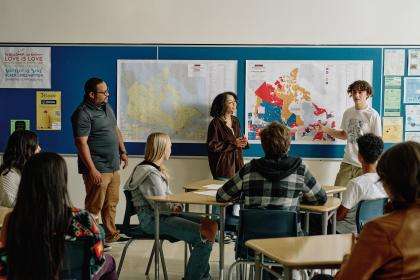
Elections Canada’s learning resource Geography of Elections contains fact sheets with data on Canada’s 338 electoral districts. After the latest federal election and the recent decennial census, the fact sheets have been updated with the newest data.
In Geography of Elections, students compare the data on their school’s riding to at least one other riding in Canada. They interpret information on population, geographic area, languages, income, etc. Check out some of the notable facts from the latest data to find out how your electoral district might compare.
Interesting facts from the latest data
Edmonton—Wetaskiwin, in Alberta, is both the riding with the most people and the riding that had the biggest change in population. Its population increased by more than 30%, from 158,749 in 2016 to 209,431 in 2021.
In terms of area, Nunavut and Toronto Centre remain the largest and smallest ridings, as well as least and most densely populated, respectively. Nunavut spans 1,836,994 km2, with a population density of 0.02 person per square kilometre. Toronto Centre measures 5.84 km2, with a population density of 20,547 people per square kilometre.
Nunavut is also the electoral district with the youngest average age (28), while Bonavista—Burin—Trinity, in Newfoundland and Labrador, has the oldest average age (50).
For the average income of individuals in 2020, both the highest and lowest were in Ontario. Humber River—Black Creek had the lowest, and Don Valley West the highest.
During the 2021 federal general election, Souris—Moose Mountain, in Saskatchewan, had the highest voter turnout with 76%.
Data on languages
Many languages are spoken across Canada. The fact sheets provide data on languages that are most often spoken at home, between English, French, Indigenous languages and other languages.
The most recent census showed that the ridings in which the most people spoke Indigenous languages at home were:
- Abitibi—Baie-James—Nunavik—Eeyou, QC
- Nunavut
- Desnethé—Missinippi—Churchill River, SK
The census data also showed which languages were spoken most often at home, other than English, French and Indigenous languages. For example, in all three territories, the most popular other language is Tagalog (Pilipino, Filipino).
Calgary Skyview is the riding with the largest number of people who speak a language other than English, French and Indigenous languages at home. In this riding, 27,755 respondents speak Punjabi (Panjabi) and 34,235 people speak other languages.
Acadie—Bathurst, in New Brunswick, is the riding with the largest French community outside Quebec. Out of 75,040 respondents, 60,330 speak French at home. That’s 80% of respondents.
In Glengarry—Prescott—Russell, in Eastern Ontario, there is another very large French community. There, 54,805 people speak French most often at home. That’s about 50% of respondents in the riding.
In Quebec, most people speak French at home. There are two ridings where French isn’t the language spoken most often at home. In Lac-Saint-Louis, 63% of the population speaks English at home, and in Notre-Dame-de-Grâce—Westmount, it’s 56%.
This data shows a few of the ways in which Canada’s 338 electoral districts are different or similar. Have your students compare their school’s riding to other ridings by using our Geography of Elections resource. Share what makes your riding unique with us on Facebook or Twitter!

